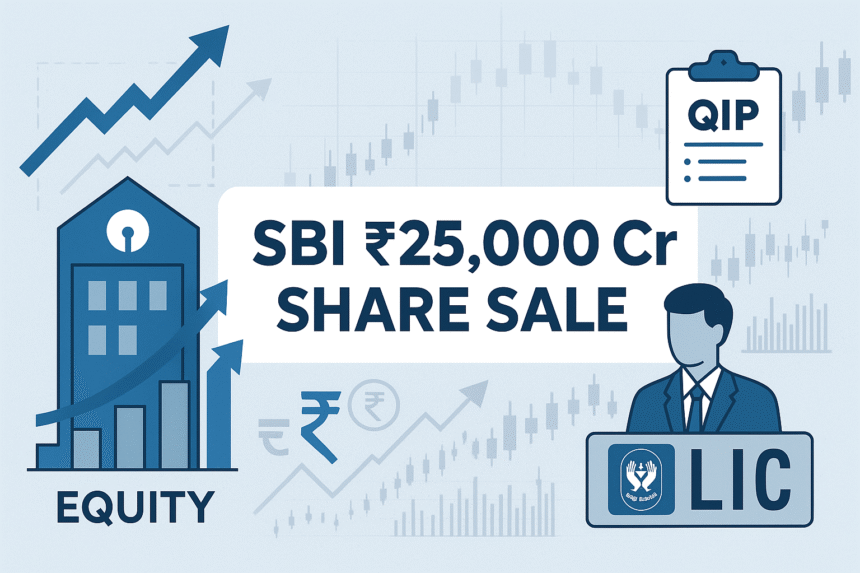In a major development that marks a new chapter in Indian banking history, the State Bank of India (SBI) has launched a massive ₹25,000 crore share sale to institutional investors through thei Qualified Institutional Placement (QIP) route. This is the largest-ever equity fundraising by any Indian bank and one of the biggest among government-backed institutions in recent memory.
So, what does this mean? Why is SBI raising money? What is a QIP? Who is buying these shares? How does it impact investors, the government, and you?
Let’s decode the entire story in simple terms.
💼 What Exactly Happened?
On Wednesday, SBI launched its third-ever QIP to raise up to ₹25,000 crore from qualified institutional buyers (QIBs), making it the largest domestic equity capital raise by a public sector bank in eight years.
This move comes as the bank prepares to bolster its capital base ahead of rising credit demand, digital expansion, and regulatory requirements.
The bidding began at the end of trading hours on Wednesday and will continue into early Thursday morning.
💰 What Is a Qualified Institutional Placement (QIP)?
A Qualified Institutional Placement (QIP) is a way for listed companies to raise capital quickly by issuing shares to institutional investors like:
- Mutual Funds
- Insurance Companies
- Pension Funds
- Foreign Institutional Investors (FIIs)
- Sovereign Wealth Funds
Unlike IPOs, QIPs are faster, cheaper, and more targeted. They don’t require extensive paperwork or SEBI clearance once the base structure is approved.
📊 Why Is SBI Raising ₹25,000 Crore?
SBI wants to:
- Strengthen its capital adequacy ratio under Basel III norms.
- Support its credit growth, which is expected to surge post-2025 reforms.
- Prepare for large-scale investments in technology, digitization, and infrastructure lending.
- Maintain competitiveness among large private sector banks like HDFC and ICICI.
In short, more capital means more power to lend, expand, and stay ahead.
💸 What Is the Price Range?
The indicative offer price for the QIP is set between:
₹806.75 to ₹831.70 per share
This pricing represents a discount of up to 3% to SBI’s closing market price of ₹831.70 on Wednesday (NSE).
This discount is common in QIPs to incentivize bulk buyers.
📈 How Big Is This Compared to the Past?
This ₹25,000 crore QIP, if fully subscribed, would surpass:
- Coal India’s ₹22,560 crore QIP in 2015
- SBI’s own last QIP in 2017, where it raised ₹15,000 crore at ₹287.25/share
That’s nearly 3x the previous price level, showcasing the tremendous market re-rating of SBI in the last 7 years.
🧾 Who Are the Likely Buyers?
✅ LIC (Life Insurance Corporation of India)
- LIC is expected to be the largest buyer, as it was in 2017.
- In the last QIP, LIC bought nearly 40% of the total offer.
✅ Other likely participants:
- Domestic mutual funds
- Large private financial institutions
- Foreign institutional investors
- Global pension funds and sovereign wealth funds
This shows strong institutional confidence in SBI’s long-term growth.
📉 Will Government Holding Drop?
Yes. As SBI issues more shares and existing ones get diluted, the government’s holding may drop to around 55% — still retaining majority control but slightly leaner.
This aligns with the government’s broader aim to:
- Free up capital
- Encourage wider ownership
- Make PSU banks more market-driven
🔄 How Does This Affect Retail Investors?
🟢 Positives:
- A successful QIP will improve SBI’s capital buffer — good for future growth.
- Institutional confidence will boost investor sentiment.
- May reduce the need for future government recapitalization.
🔴 Risks:
- Short-term volatility due to dilution concerns.
- Possible pressure on stock price if the QIP is priced closer to the lower end of the band.
However, in the long run, more capital means stronger lending capability, better balance sheets, and improved market position.
🧠 Strategic Perspective
SBI’s move is perfectly timed:
- The economy is rebounding.
- Credit offtake is accelerating.
- Capex and infrastructure spending are rising.
- Banks need capital to support growth without compromising stability.
By opting for QIP, SBI avoids increasing its debt burden and signals that it trusts market mechanisms to support its expansion.
🏛️ Government’s Silent Strategy?
The drop in government holding could also be seen as baby steps toward disinvestment, without making any official announcement.
By letting LIC and other institutional buyers take more stake, the government:
- Reduces capital commitment
- Boosts PSU performance metrics
- Invites market discipline
All this without losing controlling stake — a smart and subtle strategy.
🔍 Quick Comparison: SBI QIPs Over the Years
| Year | Amount Raised | QIP Price | LIC Participation | Market Context |
|---|---|---|---|---|
| 2010 | ₹8,000 Cr | ₹2,090 | Moderate | Pre-crisis boom |
| 2017 | ₹15,000 Cr | ₹287.25 | 40% (LIC) | Post-NPA cleanup |
| 2024 | ₹25,000 Cr | ₹806.7–₹831.7 | LIC likely again | Credit growth & digital expansion |
💬 What Analysts Say
“This is a strong move by SBI. Raising ₹25,000 crore without government help shows investor faith in the bank’s profitability and resilience.”
— Banking Sector Analyst, Mumbai
“This QIP could trigger a fresh wave of capital raising across PSU banks.”
— Equity Strategist, Mutual Fund House
🧾 Final Thoughts
This isn’t just a capital raise. It’s a declaration of SBI’s ambition.
India’s biggest bank is gearing up for India’s next big growth phase — and it’s doing so by strengthening its own capital muscle, not waiting for government bailouts.
For investors, market watchers, and policymakers, this is a moment of financial maturity and strategic evolution.
Bankinga2z.com Verdict:
Keep an eye on SBI’s QIP journey. It could set the tone for PSU banking transformation in the years ahead.







